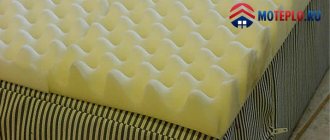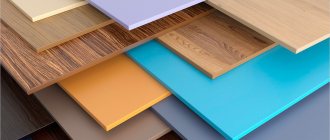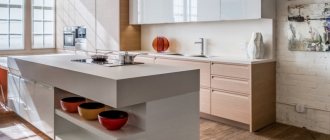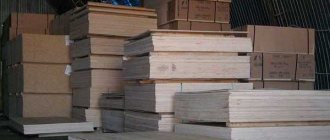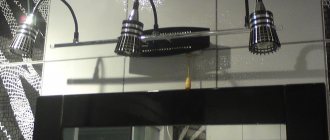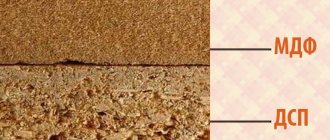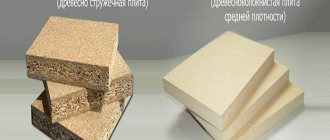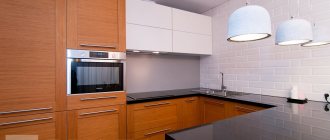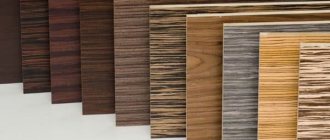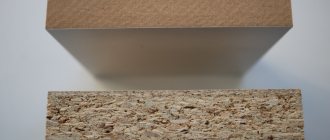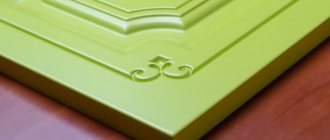Medium density fiberboard (MDF) is an engineered wood product formed from wood fibers produced by defibrating hardwood and softwood wood. The wood fibers are then glued together using wax and resin. They are turned into panels by applying high heat and pressure. The resulting smooth wood product has no wood grains and shares many of the same characteristics as particle board. However, MDF is slightly stronger than chipboard.
Plywood is made from sawmill. Thin layers are removed from wooden logs by rotating them along their horizontal axis. The veneer sheets produced by this method are cut to the desired dimensions, dried, straightened, glued, and then baked in a press at 140 °C (284 °F) and 1.9 MPa (280 psi) to form the plywood panel. Depending on the grade of plywood, it may or may not be smooth and useful for a visually pleasing wooden interior. Some types of plywood can be painted and look good for kitchen cabinetry.
Watch the video below to learn more about the differences between plywood, MDF, high-density fiberboard (HDF), chipboard and chipboard.
Plywood
Wood has been used to make furniture since ancient times, but it was a time when wood was available in abundance, and as wood scarcity increased, plywood was invented for those who could not afford teak, walnut or mahogany furniture. Plywood is made from wood, but every piece of wood is used to minimize wood loss. Plywood has many advantages, such as a variety of sizes and thicknesses. It can easily be covered with paint or laminate in any color or pattern. Plywood production minimizes wood waste, but does not eliminate it.
MDF is an abbreviation for medium density fiberboard. Since the shortage of wood prompted the invention of plywood, MDF is another product that was invented as a wood substitute. MDF is made up of small pieces of wood that are broken down into wood fibers and then compressed in a hydraulic press under very high pressure into a board. MDF boards are manufactured in various thicknesses so that they can be easily used in various industries. These slabs have a very smooth surface and the furniture they make is of very high quality in terms of attractiveness. MDF is easily laminated in a variety of shapes and colors, or painted to your choice. MDF boards are made from wood fibres, hence they have very little screw-driving capacity.
Comparison of characteristics
To choose the most suitable option for rough or fine finishing of a floor structure, it is necessary to take into account the main parameters of the product.
Environmental friendliness
Health safety is one of the main factors. The indicators of wood-based panel materials comply with the standards reflected in standardization documents.
- Plywood. Eco-friendly option. The most harmless products are those that are glued using natural resins.
Since the outside of all materials is finished, harmful fumes are minimized.
On a note! To completely protect yourself from harmful effects, when purchasing, you should check for certificates of conformity.
Strength
To choose the most reliable option, you need to take into account the density and structure of the product:
- OSB and plywood. Oriented strand panels can withstand heavy loads well: the layers are placed in different directions and glued together extremely firmly. But wood-laminated board may have a significant disadvantage - the possibility of deformation due to non-compliance with the technology.
It is difficult to compare all products on this parameter, since they have different sizes.
Dimensions
The length and width of all varieties are approximately the same, so it is necessary to compare the thickness:
- Hardboard. The thinnest material. Its thickness can reach up to 7 mm, but the most common is 3.2 mm.
- Plywood. For the floor, products with a thickness of 12–15 mm are selected.
The thickness and structure of the parts also affects protection from sound penetration and heat retention. If the noise pollution is very strong, then it is recommended to give preference to medium-density fiberboards of maximum thickness. They also serve as additional thermal insulation, which is similar to OSB.
Price
The difference in the price of materials depends on many factors: production method, raw materials used, additional processing, size and even place of sale.
- The most expensive is high-grade plywood.
- The cost of MDF is calculated per square meter and depends on the manufacturing method.
- The price of OSB-3 and 2 corresponds to wood-laminated boards of grade 3 or 2 of a smaller size.
To ensure that the total work budget does not amount to too significant an amount, it is necessary to immediately determine the scope of application of each type of product.
Easy to install
Laying wood boards is not difficult; it does not require professional skills or complex tools. The order of work depends on the specific situation:
- If a frame structure is being erected, then OSB would be the best option.
- The light weight and thickness of hardboard make processing the fastest, but it is not suitable for serious leveling.
- Chipboard and OSB panels are cut and fixed almost identically. They are much easier to trim than MDF, which due to its dense structure offers more resistance.
- The most labor-intensive material to process is plywood. It will take much longer to place the product. It is more difficult to drill or adjust to size due to the presence of layers of natural wood in the structure.
Features of MDF
The material is a board made of wood fibers, resins and various binders. All components are pressed under high temperature and pressure. The price of an MDF board is not high, it starts from 9 euros. However, it is considered a high-quality material with good performance characteristics:
is an environmentally friendly product;
lends itself well to various types of mechanical processing;
decorative films can be applied to the surface to give the material an aesthetic appearance;
provides excellent sound insulation;
resistant to the formation of fungus and mold;
It is resistant to moisture, so MDF products can be used in rooms with high levels of humidity, such as the kitchen or bathroom;
resistant to temperature fluctuations.
Most often, MDF is used for the production of cabinet furniture. Desks, kitchen sets, dressing tables and other products made from chipboard can be found in almost every home, apartment or office. Such furniture harmoniously combines affordable cost and optimal performance characteristics.
Key Differences
Plywood and MDF are quite similar materials. They are made from wood, used in furniture production, and are flexible in operation. However, they have some differences:
plywood is made from solid wood, and MDF board is made from wood fibers;
plywood boards are large in size, unlike MDF;
to install MDF you need special equipment, but to install plywood it is enough to use ordinary screws or nails;
MDF surface is more suitable for furniture production.
Now you know the difference between plywood and MDF. Which material to choose, decide based on the characteristics of further operation.
Source: v-kosmose.com
OSB or OSB
The basis of the slab is flat chips of rectangular cross-section, pressed under high pressure and temperature. To increase the strength of the slab, the chips located in the outer and inner layers are located in the longitudinal and transverse directions, respectively.
Depending on the degree of protection against moisture and the level of mechanical strength, four separate classes are distinguished. The most protected are OSB-4, which can be used for cladding rooms with high levels of humidity, while OSB-1 is only suitable for finishing dry rooms. The material is often used in the construction of frame houses consisting of sandwich panels, allowing significant savings on cladding work.
Use in construction
Plywood is used in house construction.
MDF is used for doors and interior panels in construction, where moisture is not likely to damage it, but was developed exclusively for furniture. As such, it is mainly used for indoor applications.
Plywood is used for doors, exterior stairs, exterior cladding, flooring, framing, interior railings and balustrades, interior stairs, interior paneling, shear walls, wood millwork, and wood frame portals in construction. Plywood bends easily with the grain, so it is often used to create curved surfaces. For example, the top smooth surface is sometimes used to create the curved slopes of a skateboard.
Source: ru.betweenmates.com
MDF or Plywood.
#1 OFFLINE Rus23
- Blues resident
- 8 messages
- Registration: 03/13/2006
- Top
#2 OFFLINE kib
- From: Almaty/KZ
Express your opinion, which is better MDF or plywood? What is better when making acoustic design for a subwoofer? I decided on the parameters, calculated the parameters and type of box using the program. I decide on the material. The manufacturer writes somewhat evasively, if you want, take 22 mm plywood, or if you want 19 mm MDF.
- Top
#3 OFFLINE Rus23
MDF 30. because the material is denser. I really need protection from moisture...
- Top
#4 OFFLINE kib
- From: Almaty/KZ
How to do it? (Moisture protection)
- Top
#5 OFFLINE Rus23
- Top
#6 OFFLINE kib
- From: Almaty/KZ
Thank you brother. Another question: the manufacturer writes that it is advisable to strengthen the walls of the box with staples if the body is made of MDF - otherwise it says there will be a squelching sound. Is it spacers to do inside? or attach metal brackets to the walls? which is correct?
- Top
Kitchen Alliance set of modules 1.8 m
Beige Beige White White Burgundy CHERRY Green green Brown Brown Red Red Gray gray Blue Blue
Plywood
There is one more drawback - this material, like natural wood, can warp somewhat . Therefore, it is not the best choice for modern kitchen projects. Although for classic kitchens that have a complex facade structure that masks the effects of warping, the degree of warping is quite acceptable and does not interfere with the construction of kitchens of the highest quality.
What material are they made from?
First of all, the difference between fiberboard and plywood lies directly in the materials from which they are made.
Fibreboard - consists of multidirectional fibers glued together using special resins. The basis of the product is a fibrous mass produced by grinding and splitting wood waste.
Depending on the production technology, fiberboards of varying strength and hardness are produced. This is achieved by using various adhesives, additives for strength, moisture resistance, and more. Conventional fiberboard, without appropriate additives, is not intended for wet rooms.
It also depends on the pressing technology. As a result, fiberboard is obtained with different parameters and characteristics, both in strength and size.
Plywood, in turn, is made from peeled veneer, which is glued together with synthetic resins. As a result, a pronounced multilayer structure is formed, which can be observed at the ends of the sheets. Veneer is made from whole dried wood using a variety of methods.
The veneer can be birch, which is the most durable, or coniferous. Sometimes, to reduce the cost, the outer layers are made of birch veneer, and the inner layers are made of coniferous veneer.
Thus, we can highlight the main differences between plywood and fiberboard:
- Material (shredded wood waste and peeled veneer).
- Production technology (fibreboard differs from plywood production).
It must be said that it is these differences that determine the properties of materials. For example, fiberboard in its structure is a homogeneous multilayer slab, in which, by definition, there cannot be any voids. But at the same time, the strength of the product depends entirely on the density, as well as on the composition of the adhesive mass and special additives.
Many probably remember loose, fragile slabs and, in comparison with them, plywood looked much more attractive. However, modern fibreboards (fibreboards) have great strength, as well as resistance to moisture and adverse factors.
Such modern slabs are produced by hot pressing, which allows the product to become competitive.
comparison table
Comparison chart of MDF and plywood
| MDF | plywood | |
(139 ratings) |
(188 ratings) | |
| tripartite | Wood fibers obtained by breaking down hardwood and softwood are combined using wax and resin and heat-pressed. | Thin sheets of veneer glued together |
| Structure | Uniform, smooth and free of knots. | An odd number of layers with grains from adjacent layers at right angles to each other. Facial veneers are higher quality than basic veneers. |
| Security threat | Use of urea-formaldehyde and phenol-formaldehyde resins, which are carcinogenic in very high concentrations | Use of urea-formaldehyde and phenol-formaldehyde resins, which are carcinogenic in very high concentrations |
| Benefits | Cabinet Construction, Crafts, Moldings/Finishing, Shelving (Sliding Bookshelves) | Roofs, walls, bases, boxes, bags, sports equipment, music equipment, gaming equipment, high quality loudspeakers |
| Description | • Has a smooth, even surface. •Easy to process, paint or stain. • Available in water and fire resistant form. • Can be machined. | • Very strong board constructed from layers of veneers or layers that are glued with grains 900 degrees to each other • Available in internal and external grades • Very strong waterproof plywood (WBP) that can be used in extreme conditions. |
Chipboard and plywood: differences and advantages
In order to better understand the differences between board and particle board materials, we will study their advantages and scope of use separately, and then compare them according to the main criteria.
- good strength characteristics due to the arrangement of adjacent veneer sheets perpendicular to each other;
- high moisture resistance, especially in FSF and FBS. Plywood of these brands is used for exterior decoration, as well as for the construction of hydraulic structures. FC and FBA are used for interior work, arrangement of dry rooms and furniture production;
- resistance to temperature changes. Plywood does not dry out when the weather changes;
- ease of processing. Plywood is easier to cut than chipboard. Due to this, it becomes possible to produce parts of complex shapes.
- high strength due to the homogeneity of the material and the perpendicular arrangement of the chips relative to each other in adjacent layers;
- heat and sound insulation. The use of small chips reduces the thermal conductivity of the material and increases noise absorption;
- good water resistance, resistance to wear and biocontamination;
- affordable cost compared to plywood of similar sizes and characteristics;
- aesthetic appearance (laminated chipboard).
Solid wood
Solid wood has been the main material for furniture for thousands of years. For purposes of purpose, solid wood refers to natural materials, where the term engineered wood refers to other types of wood materials, such as MDF. While solid wood consists only of wood, engineered wood is a mixture of natural wood, veneer, fibers, resin and adhesive.
Benefits of solid wood
- Strength and durability – solid wood as a material is very durable and strong. If you are looking to buy something that will last for decades, solid wood furniture is ideal. Solid wood is so durable that it is used all over the world - entire buildings and even bridges are erected. Of course, different types of wood have different strength limits. For example, oak is stronger and will last longer than cedar.
- Aesthetics – In terms of appearance, solid wood is very beautiful. It has a beautiful texture, which leads to a wide variety of furniture. If aesthetics and style are your top priority, then hardwood is a great choice. But just like strength and durability, different types of wood have different aesthetic qualities. For example, red oak is stronger than white oak, white oak is used because it has a better appearance.
- Bespoke - When using solid wood, furniture can be customized including look, finish and colour.
- Value – Solid wood furniture has more value than engineered wood furniture, although MDF furniture can be quite expensive in some cases. For homeowners looking to get the best price for their home, adding hardwood features can increase the price.
- Variety – There are many types of wood, each varying in strength, cost and appearance. You can take a look at our gallery for an idea of what options you may have for your furniture. Add to this the many varieties of stains and finishes available, and you may find something unique for your home.
Disadvantages of solid wood
- Damage from moisture - in an unfinished (unfinished) state, wood is not waterproof. Although stronger woods such as red oak can withstand constant exposure to moisture, most will become damaged. Waterproof finishes are commonly used to protect wood.
- Warping and cracking – Wood tends to expand and contract with changes in temperature and humidity. The result is a tendency for hardwood furniture to warp or even crack when exposed to fluctuations in temperature and humidity. Cracking can be even more noticeable when the wood has been painted. Over time, wood manufacturers have developed methods and technologies that minimize warping and cracking.
- Insect Infestation – Solid wood is more vulnerable to pests than engineered wood. Natural wood, and hardwood in particular, requires regular maintenance and proper finishing. To preserve wood, it must be reliably protected.
For people who prefer a cheaper, but at the same time durable material, they see MDF as an alternative to hardwood. What is MDF?
MDF is an abbreviation for engineered wood: the full name is Medium Density Fiberboard. MDF panels are made from wood fiber, resin and wax. When it comes to engineered wood, MDF is often priced higher than plywood. MDF is denser, stronger and more durable. For these reasons, it has almost as many uses as hardwood.
Many homeowners tend to look at MDF with the understanding that it is inferior compared to hardwood. But, as we mentioned at the beginning, both solid wood and MDF have their good and bad qualities. There are situations where MDF is preferable.
What is the difference between plywood and chipboard?
Both materials contain wood. But plywood is called more environmentally friendly. And that's why:
Plywood is layers of veneer firmly glued together. Essentially, the material consists of the thinnest sheets of inexpensive wood and synthetic layers.
Both of these materials are used as a rough substrate for laminate, parquet, linoleum and other floor coverings. Using chipboard or plywood, the surface is leveled and insulated. The result is a higher quality, stronger and more durable coating.
"PRICE QUALITY"
Currently, very popular construction, finishing, and also materials used in the manufacture of furniture are chipboard, plywood, and MDF. And it is difficult to find a person who has never heard of the existence of these materials. However, if we summarize the priority of choosing a base for artificial stone products among the many requests to us, it can be noted that there is no unanimous opinion or agreement yet. Of course, your choice has been and will be one of the important criteria for us when placing an order; our task is to help you choose materials worthy of attention at affordable prices.
This article will describe the main criteria of these materials, as well as how chipboard, plywood and MDF are similar, and how they differ from each other.
Differences between MDF and chipboard
Upon detailed study of wood products, you will find that most furniture is made from laminated chipboard and MDF. Deciphering these concepts will help determine the quality of the material.
Laminated chipboard is a board made from various secondary raw materials from the woodworking industry. The basis is sawdust of deciduous and coniferous wood. They are glued together using hot pressing. To increase the viscosity and strength of the material, adhesive resins are added to the composition, including formaldehyde and other synthetic substances.
MDF translated into Russian means wood fiber board, which has a medium density and is made from a fine fraction of wood. This material is also made from sawdust, but of a smaller fraction. You can clearly see this by seeing MDF in cross-section. The smallest sawdust is first wiped, and then dried until complete loss of moisture and glued together.
You can compare the difference between MDF and laminated chipboard using several parameters:
- appearance;
- strength;
- water resistance;
- fire resistance;
- density;
- final cost and cost;
- environmental friendliness;
- scope of application.
In the production of laminated chipboard, after the base is completely ready and all the sawdust is securely fastened and forms a monolithic tile, a laminating film is used. It allows you to use the material for creating and assembling bedroom furniture, as well as for packaging.
The difference between MDF and laminated chipboard is noticeable already at the production stage. For the manufacture of MDF, raw materials ground in a combine are used. Often this is various waste left over from wood processing in the woodworking industry. The base undergoes cleaning and moistening with steam, and an additional grinding procedure through a defiberizer.
Next, natural and natural resins and other substances that contain lignin and paraffin are added to them. All this together allows us to obtain raw materials that are not inferior in quality to natural wood. MDF is used as a basis for furniture - beds and wardrobes, and other products.
A more detailed comparison of MDF and laminated chipboard can be made by visually examining these two materials in cross-section. Furniture made from MDF looks more expensive and is heavier in weight.
External differences
You can visually distinguish chipboard from MDF by several criteria. Features of MDF are:
- smooth surface;
- the cut of the material is uniform, with the presence of fine grain;
- easy to process.
Distinctive features of laminated chipboard include a strong smell of adhesive, as well as an uneven and sometimes rough surface. A detailed examination of the cut reveals large pieces of sawdust, and the material itself may have small voids. This negatively affects the possibility of using laminated chipboard, since when screws and bolts are screwed in, crumbs are formed, and the cut site itself looks unattractive.
Tags: laugh)
Comments 74
I always assemble boxes only from MDF, not a lot, but I have already assembled 6 boxes... And now I also bought MDF for my biggest box. Why MDF? There is money for both, but as practice has shown, it is very convenient to work with MDF - to give shape, round off joints... especially when we are talking about boxes of a complex shape, where the walls are at angles... I tried it with plywood... personally, I didn’t like the torn cuts, I always drive the screws into MDF without drilling and nothing delaminates, but in 18mm plywood it immediately comes apart at the seams, especially the problem is not to assemble the phasic along the wall, when you first assemble it and then fix it inside the box... it constantly delaminates... MDF does not siphon or ring, it is heavy and, to me, it has a deeper sound... I always paint MDF inside and out, and coat the outside with waterproof mastic, it turns out a bomb... But the only thing I want to try is construction plywood for monolithic buildings, it is the most durable, it is used for pouring concrete, i.e. it gives shape... In stores, very expensive sheet 240X120 $80 versus MDF 240X120 $30, all 18mm.
look at the boxes people sculpt here))) plywood is closer to them)))
They probably know better...More precisely, it’s more affordable and affordable...:)))
Hi all! In St. Petersburg I visited castorams, obi, maxidoms 2 months ago, there is no MDF there! I had to sculpt it from plywood. I'm for MDF!
